HA 3011 Advanced Financial Accounting: Enron & Coca-Cola Report
VerifiedAdded on 2023/06/04
|12
|1100
|138
Report
AI Summary
This report provides a detailed analysis of the financial practices of Enron and Coca-Cola. The first part of the report focuses on Enron, examining the use and misuse of mark-to-market accounting, special purpose entities (SPEs), and stock option plans. It explores how these accounting approaches and financial instruments were used, and the implications of each. The second part of the report analyzes the methodologies used by Coca-Cola to measure its financial elements, including sales, finance costs, taxation, intangible assets, property, plant, and equipment, associates and joint arrangements, inventories, trade receivables, trade payables, net debt, and equity. The report also compares the effective interest rate method with the straight-line method for measuring trade receivables, concluding that the effective interest rate method is more accurate. The study uses the IFRS conceptual framework, which prefers the use of fair value and amortisation cost to obtain the real value of a financial element.

Decision-Making
&
Problem-Solving
&
Problem-Solving
Paraphrase This Document
Need a fresh take? Get an instant paraphrase of this document with our AI Paraphraser
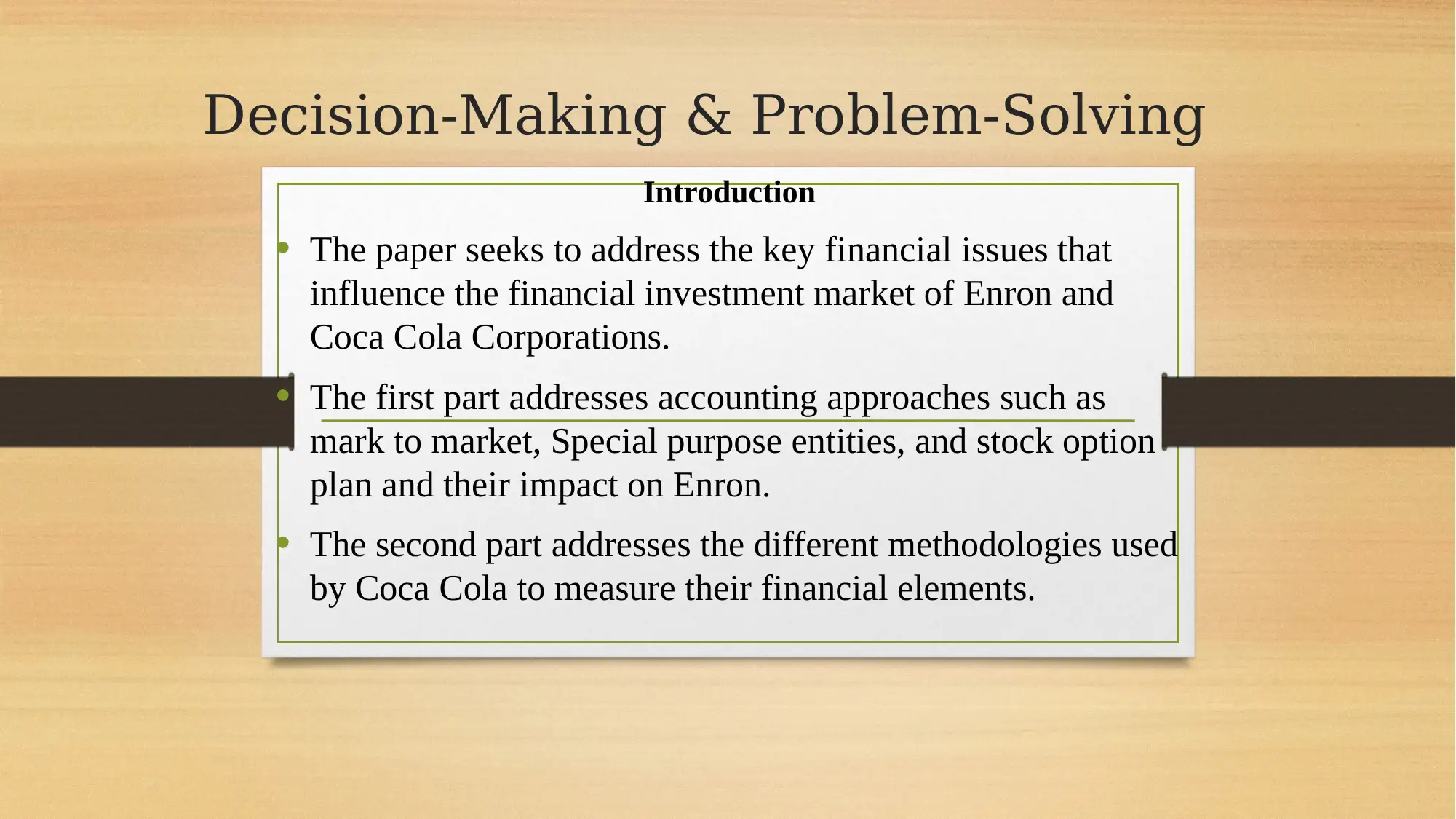
Decision-Making & Problem-Solving
Introduction
• The paper seeks to address the key financial issues that
influence the financial investment market of Enron and
Coca Cola Corporations.
• The first part addresses accounting approaches such as
mark to market, Special purpose entities, and stock option
plan and their impact on Enron.
• The second part addresses the different methodologies used
by Coca Cola to measure their financial elements.
Introduction
• The paper seeks to address the key financial issues that
influence the financial investment market of Enron and
Coca Cola Corporations.
• The first part addresses accounting approaches such as
mark to market, Special purpose entities, and stock option
plan and their impact on Enron.
• The second part addresses the different methodologies used
by Coca Cola to measure their financial elements.
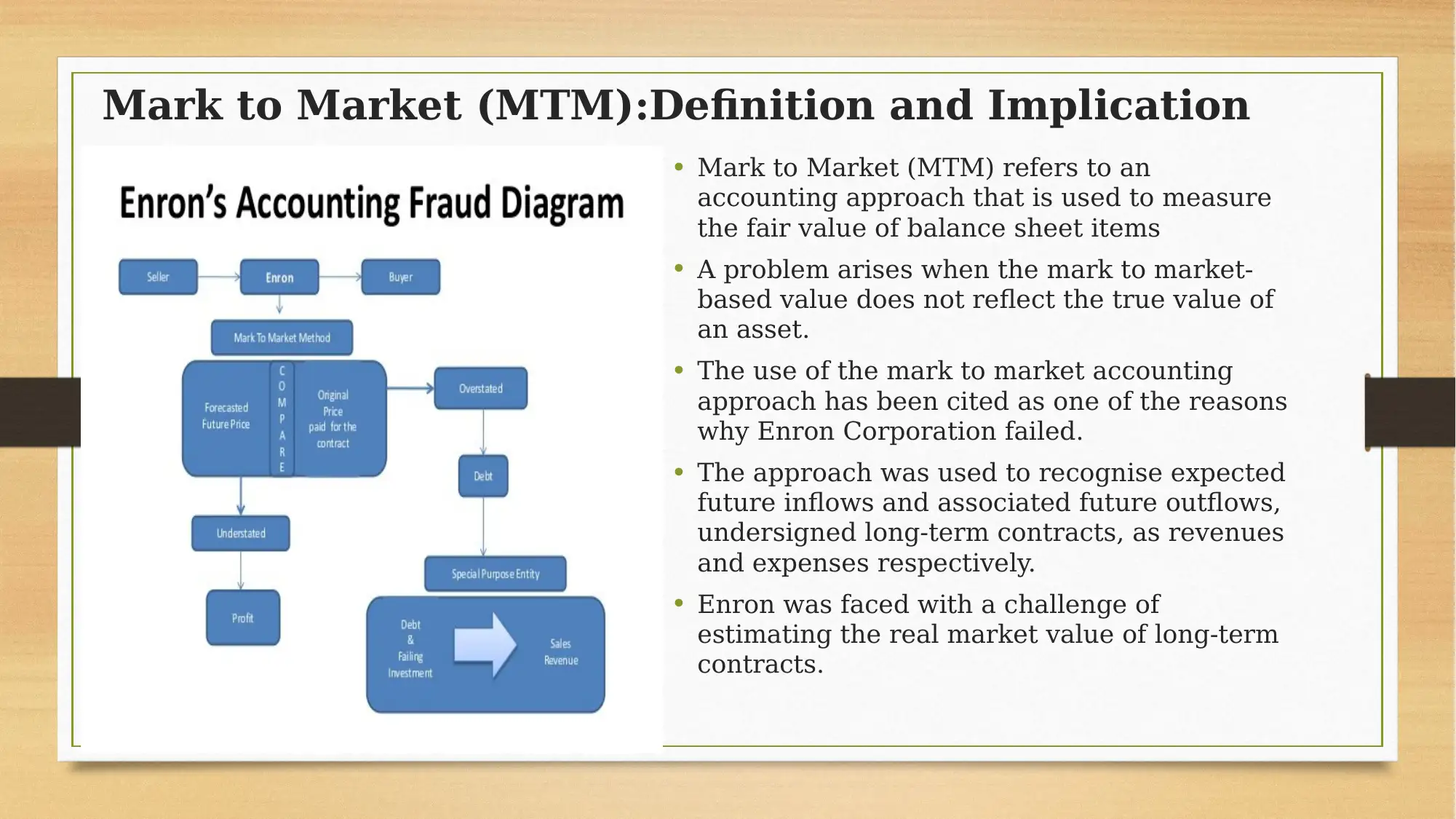
Mark to Market (MTM):Definition and Implication
• Mark to Market (MTM) refers to an
accounting approach that is used to measure
the fair value of balance sheet items
• A problem arises when the mark to market-
based value does not reflect the true value of
an asset.
• The use of the mark to market accounting
approach has been cited as one of the reasons
why Enron Corporation failed.
• The approach was used to recognise expected
future inflows and associated future outflows,
undersigned long-term contracts, as revenues
and expenses respectively.
• Enron was faced with a challenge of
estimating the real market value of long-term
contracts.
• Mark to Market (MTM) refers to an
accounting approach that is used to measure
the fair value of balance sheet items
• A problem arises when the mark to market-
based value does not reflect the true value of
an asset.
• The use of the mark to market accounting
approach has been cited as one of the reasons
why Enron Corporation failed.
• The approach was used to recognise expected
future inflows and associated future outflows,
undersigned long-term contracts, as revenues
and expenses respectively.
• Enron was faced with a challenge of
estimating the real market value of long-term
contracts.
⊘ This is a preview!⊘
Do you want full access?
Subscribe today to unlock all pages.

Trusted by 1+ million students worldwide
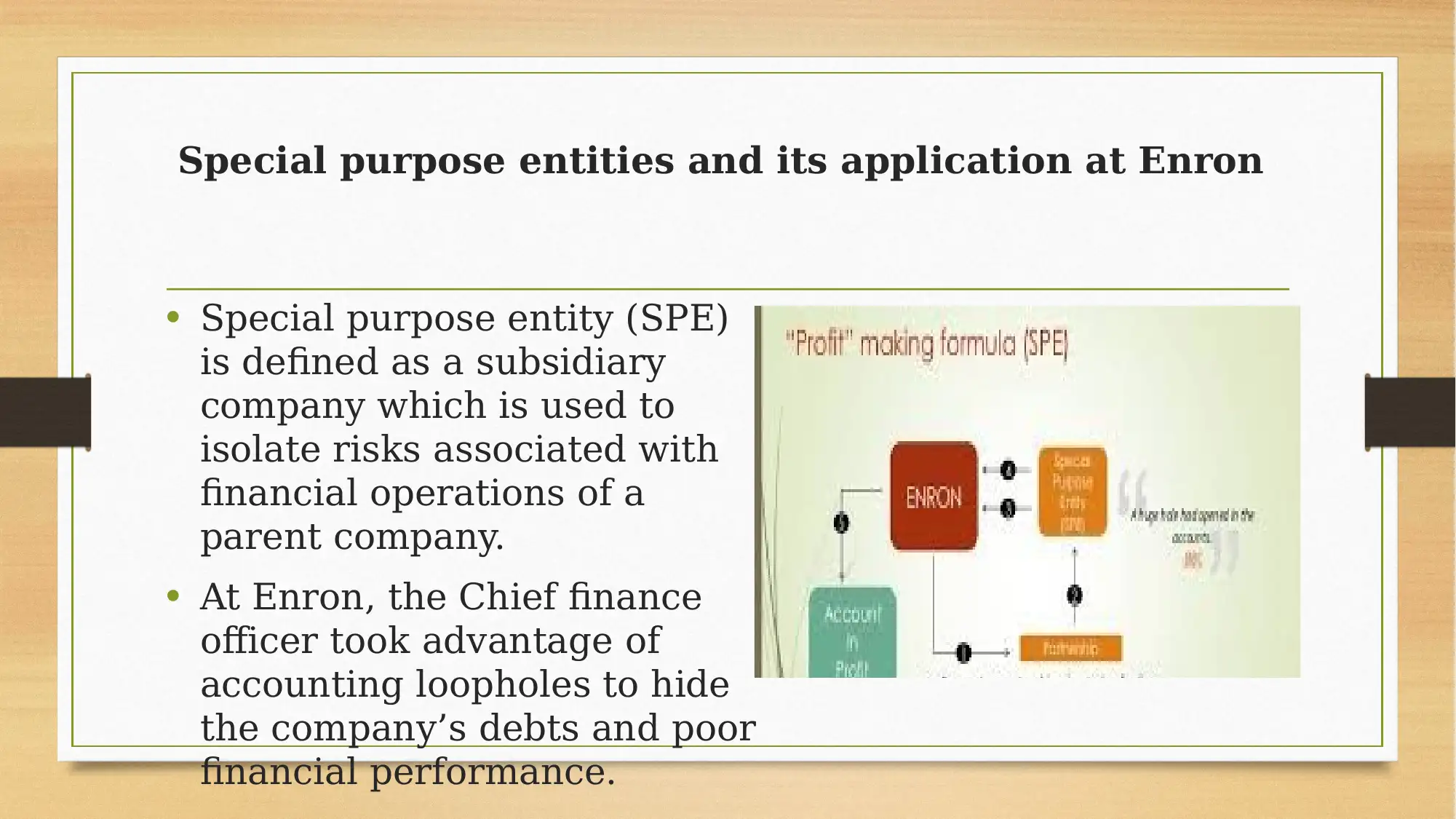
Special purpose entities and its application at Enron
• Special purpose entity (SPE)
is defined as a subsidiary
company which is used to
isolate risks associated with
financial operations of a
parent company.
• At Enron, the Chief finance
officer took advantage of
accounting loopholes to hide
the company’s debts and poor
financial performance.
• Special purpose entity (SPE)
is defined as a subsidiary
company which is used to
isolate risks associated with
financial operations of a
parent company.
• At Enron, the Chief finance
officer took advantage of
accounting loopholes to hide
the company’s debts and poor
financial performance.
Paraphrase This Document
Need a fresh take? Get an instant paraphrase of this document with our AI Paraphraser
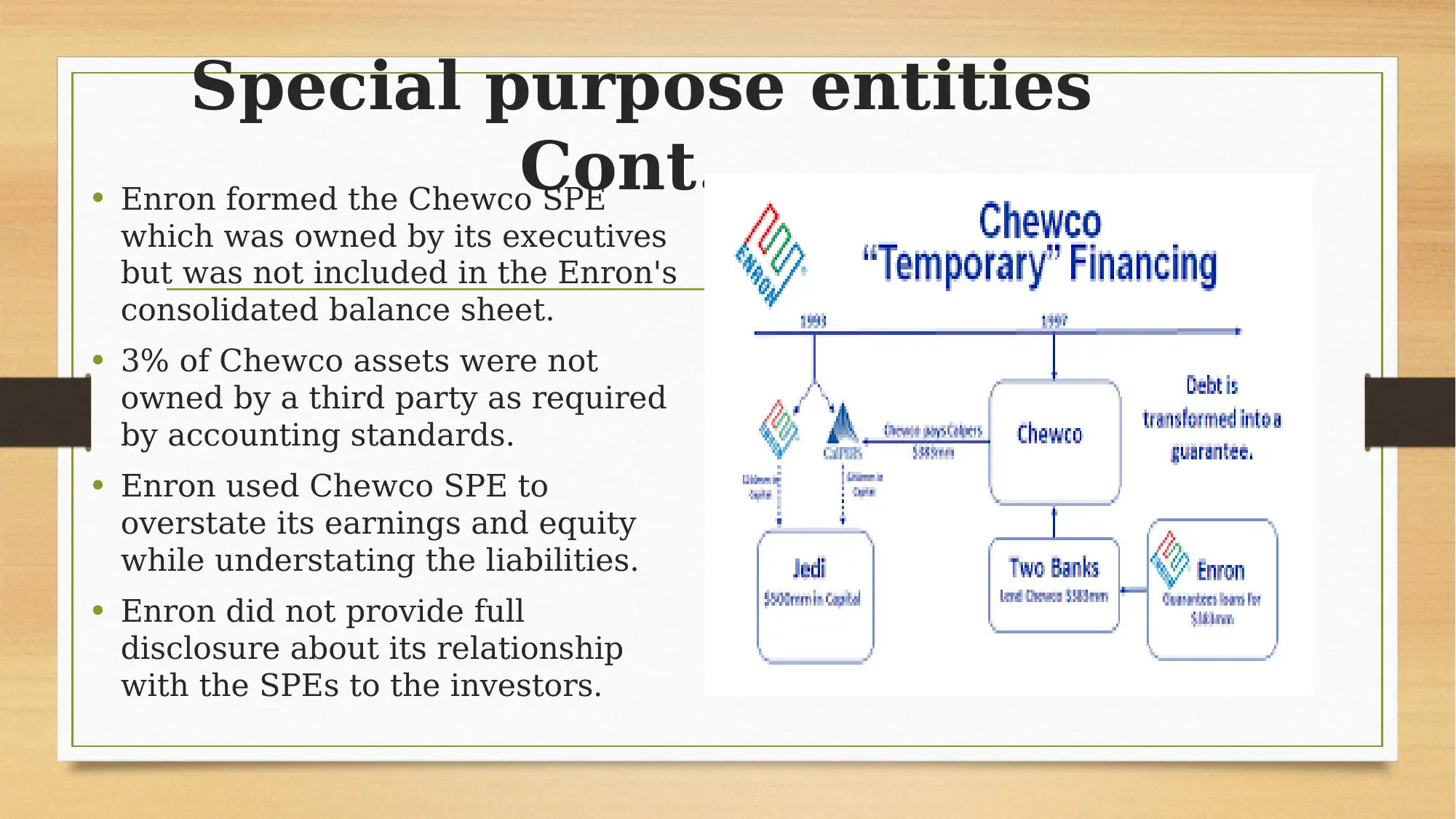
Special purpose entities
Cont…• Enron formed the Chewco SPE
which was owned by its executives
but was not included in the Enron's
consolidated balance sheet.
• 3% of Chewco assets were not
owned by a third party as required
by accounting standards.
• Enron used Chewco SPE to
overstate its earnings and equity
while understating the liabilities.
• Enron did not provide full
disclosure about its relationship
with the SPEs to the investors.
Cont…• Enron formed the Chewco SPE
which was owned by its executives
but was not included in the Enron's
consolidated balance sheet.
• 3% of Chewco assets were not
owned by a third party as required
by accounting standards.
• Enron used Chewco SPE to
overstate its earnings and equity
while understating the liabilities.
• Enron did not provide full
disclosure about its relationship
with the SPEs to the investors.
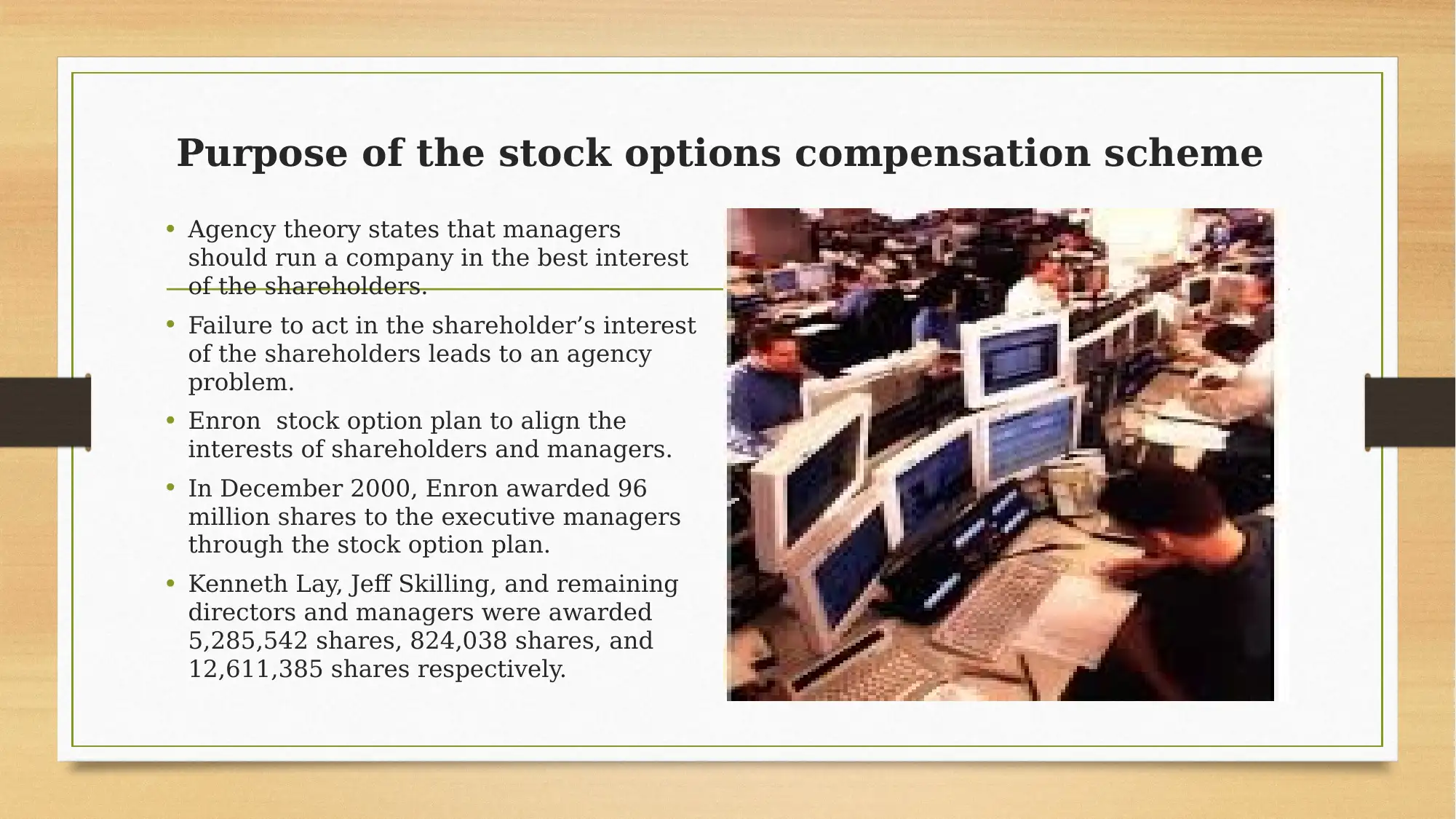
Purpose of the stock options compensation scheme
• Agency theory states that managers
should run a company in the best interest
of the shareholders.
• Failure to act in the shareholder’s interest
of the shareholders leads to an agency
problem.
• Enron stock option plan to align the
interests of shareholders and managers.
• In December 2000, Enron awarded 96
million shares to the executive managers
through the stock option plan.
• Kenneth Lay, Jeff Skilling, and remaining
directors and managers were awarded
5,285,542 shares, 824,038 shares, and
12,611,385 shares respectively.
• Agency theory states that managers
should run a company in the best interest
of the shareholders.
• Failure to act in the shareholder’s interest
of the shareholders leads to an agency
problem.
• Enron stock option plan to align the
interests of shareholders and managers.
• In December 2000, Enron awarded 96
million shares to the executive managers
through the stock option plan.
• Kenneth Lay, Jeff Skilling, and remaining
directors and managers were awarded
5,285,542 shares, 824,038 shares, and
12,611,385 shares respectively.
⊘ This is a preview!⊘
Do you want full access?
Subscribe today to unlock all pages.

Trusted by 1+ million students worldwide
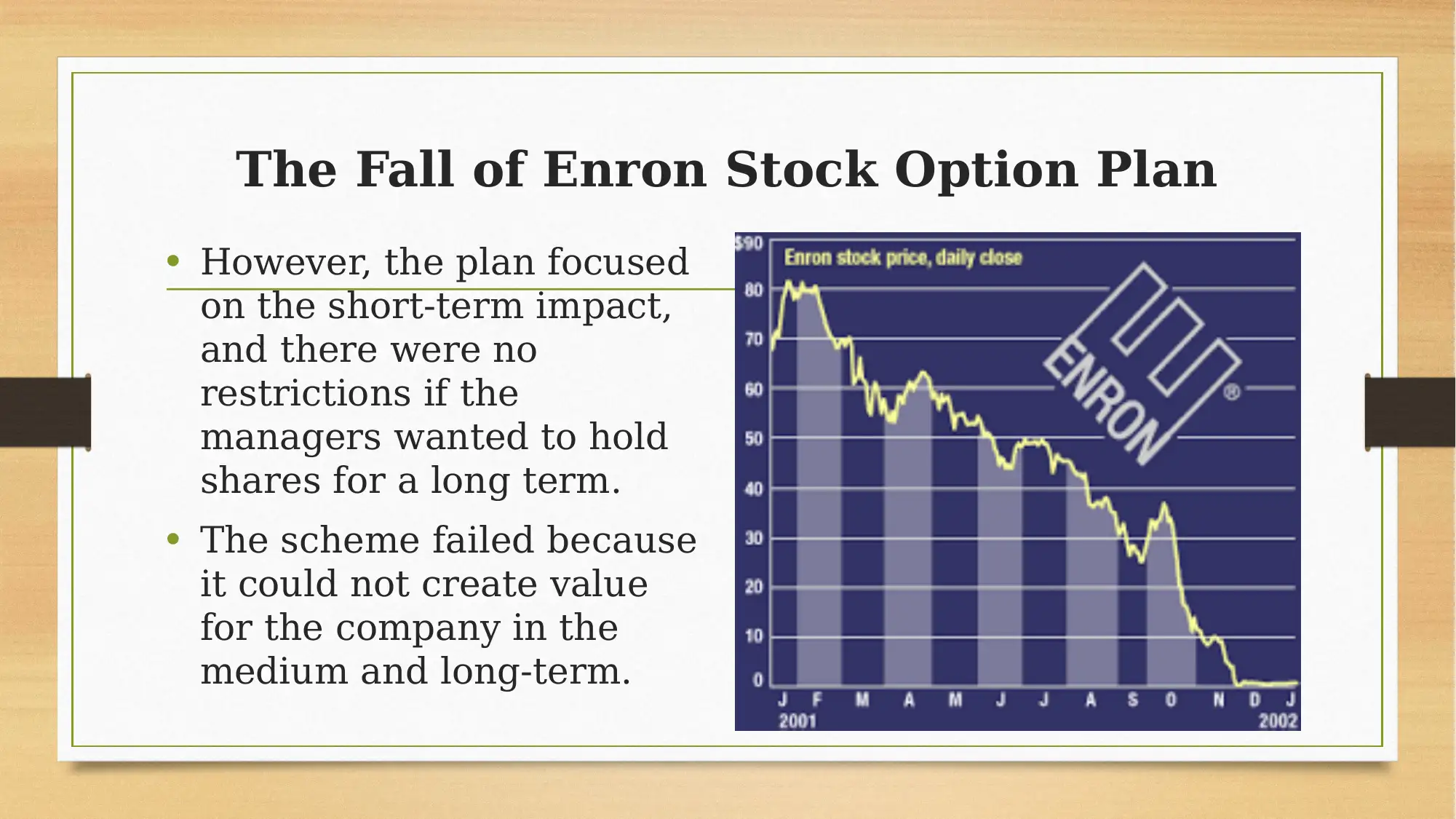
The Fall of Enron Stock Option Plan
• However, the plan focused
on the short-term impact,
and there were no
restrictions if the
managers wanted to hold
shares for a long term.
• The scheme failed because
it could not create value
for the company in the
medium and long-term.
• However, the plan focused
on the short-term impact,
and there were no
restrictions if the
managers wanted to hold
shares for a long term.
• The scheme failed because
it could not create value
for the company in the
medium and long-term.
Paraphrase This Document
Need a fresh take? Get an instant paraphrase of this document with our AI Paraphraser
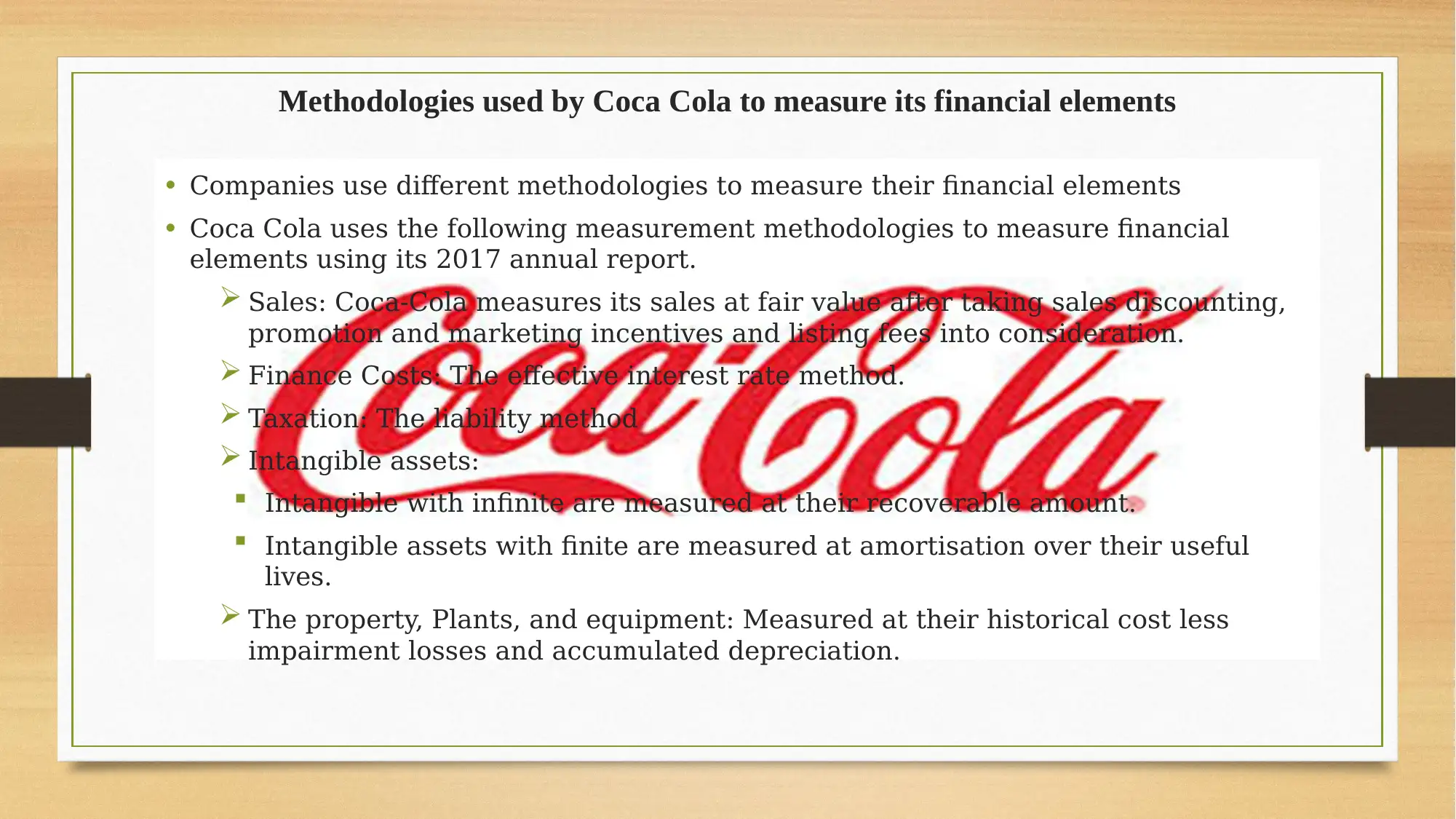
Methodologies used by Coca Cola to measure its financial elements
• Companies use different methodologies to measure their financial elements
• Coca Cola uses the following measurement methodologies to measure financial
elements using its 2017 annual report.
Sales: Coca-Cola measures its sales at fair value after taking sales discounting,
promotion and marketing incentives and listing fees into consideration.
Finance Costs: The effective interest rate method.
Taxation: The liability method
Intangible assets:
Intangible with infinite are measured at their recoverable amount.
Intangible assets with finite are measured at amortisation over their useful
lives.
The property, Plants, and equipment: Measured at their historical cost less
impairment losses and accumulated depreciation.
• Companies use different methodologies to measure their financial elements
• Coca Cola uses the following measurement methodologies to measure financial
elements using its 2017 annual report.
Sales: Coca-Cola measures its sales at fair value after taking sales discounting,
promotion and marketing incentives and listing fees into consideration.
Finance Costs: The effective interest rate method.
Taxation: The liability method
Intangible assets:
Intangible with infinite are measured at their recoverable amount.
Intangible assets with finite are measured at amortisation over their useful
lives.
The property, Plants, and equipment: Measured at their historical cost less
impairment losses and accumulated depreciation.
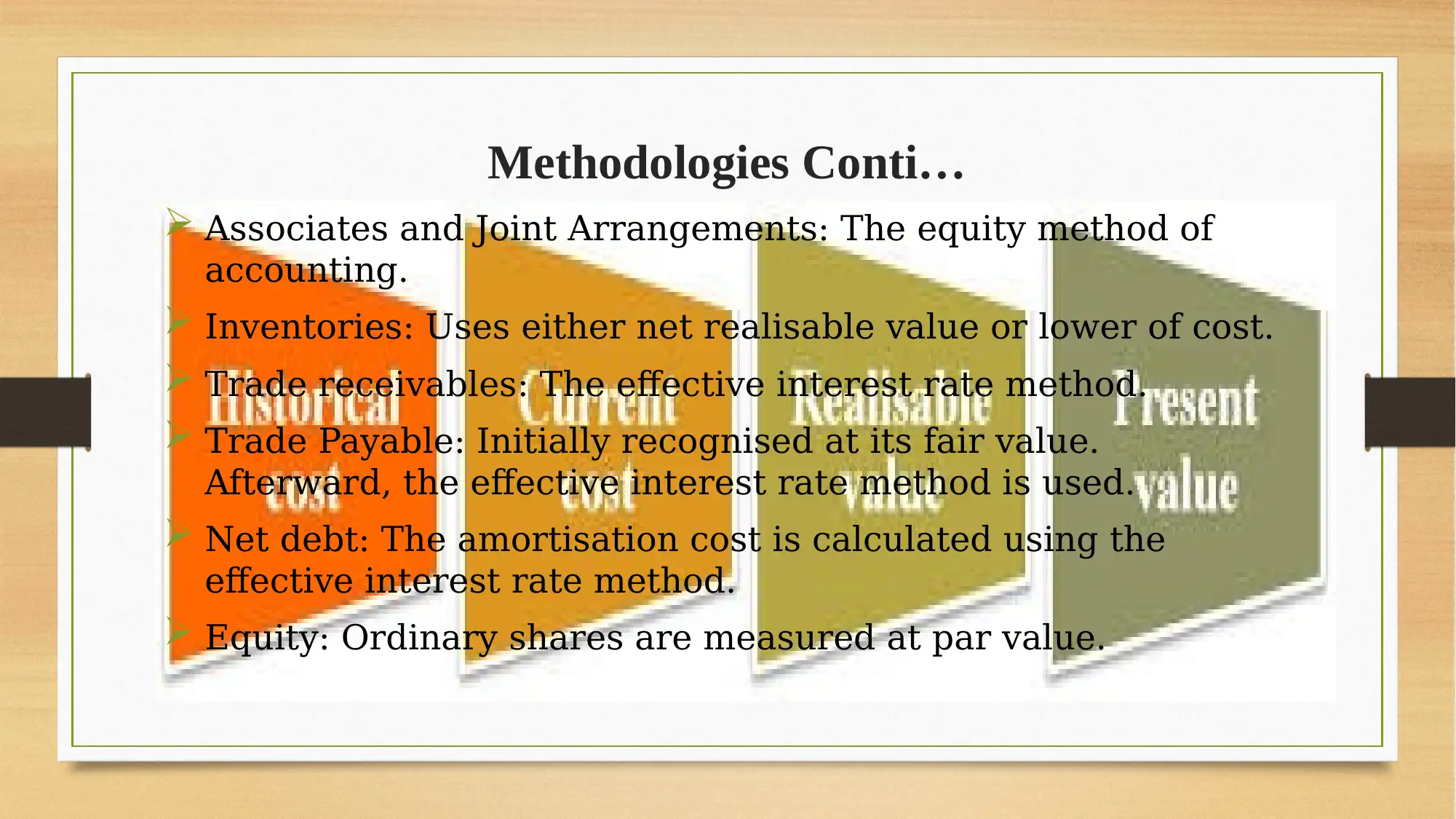
Methodologies Conti…
Associates and Joint Arrangements: The equity method of
accounting.
Inventories: Uses either net realisable value or lower of cost.
Trade receivables: The effective interest rate method.
Trade Payable: Initially recognised at its fair value.
Afterward, the effective interest rate method is used.
Net debt: The amortisation cost is calculated using the
effective interest rate method.
Equity: Ordinary shares are measured at par value.
Associates and Joint Arrangements: The equity method of
accounting.
Inventories: Uses either net realisable value or lower of cost.
Trade receivables: The effective interest rate method.
Trade Payable: Initially recognised at its fair value.
Afterward, the effective interest rate method is used.
Net debt: The amortisation cost is calculated using the
effective interest rate method.
Equity: Ordinary shares are measured at par value.
⊘ This is a preview!⊘
Do you want full access?
Subscribe today to unlock all pages.

Trusted by 1+ million students worldwide
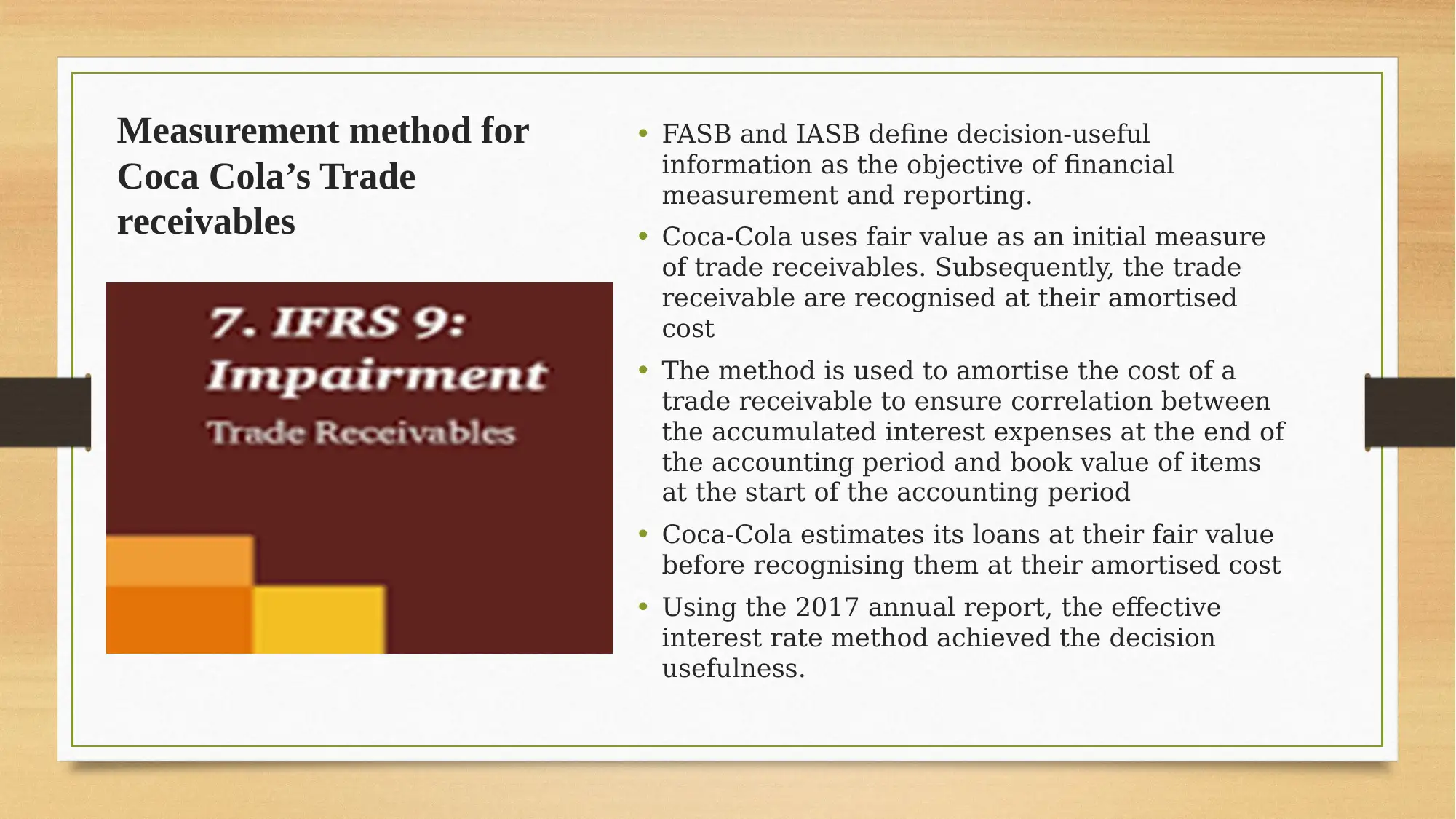
Measurement method for
Coca Cola’s Trade
receivables
• FASB and IASB define decision-useful
information as the objective of financial
measurement and reporting.
• Coca-Cola uses fair value as an initial measure
of trade receivables. Subsequently, the trade
receivable are recognised at their amortised
cost
• The method is used to amortise the cost of a
trade receivable to ensure correlation between
the accumulated interest expenses at the end of
the accounting period and book value of items
at the start of the accounting period
• Coca-Cola estimates its loans at their fair value
before recognising them at their amortised cost
• Using the 2017 annual report, the effective
interest rate method achieved the decision
usefulness.
Coca Cola’s Trade
receivables
• FASB and IASB define decision-useful
information as the objective of financial
measurement and reporting.
• Coca-Cola uses fair value as an initial measure
of trade receivables. Subsequently, the trade
receivable are recognised at their amortised
cost
• The method is used to amortise the cost of a
trade receivable to ensure correlation between
the accumulated interest expenses at the end of
the accounting period and book value of items
at the start of the accounting period
• Coca-Cola estimates its loans at their fair value
before recognising them at their amortised cost
• Using the 2017 annual report, the effective
interest rate method achieved the decision
usefulness.
Paraphrase This Document
Need a fresh take? Get an instant paraphrase of this document with our AI Paraphraser
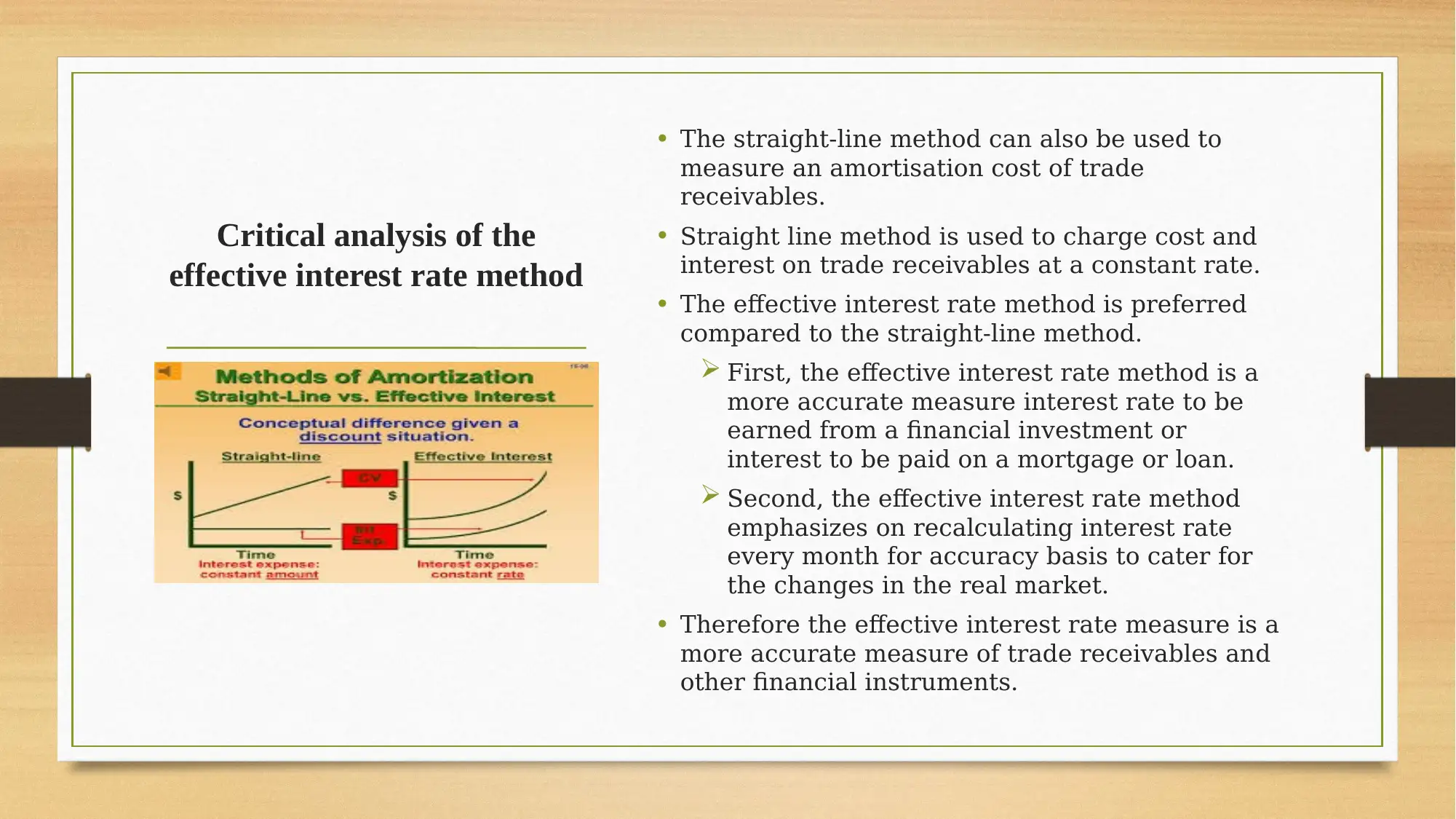
Critical analysis of the
effective interest rate method
• The straight-line method can also be used to
measure an amortisation cost of trade
receivables.
• Straight line method is used to charge cost and
interest on trade receivables at a constant rate.
• The effective interest rate method is preferred
compared to the straight-line method.
First, the effective interest rate method is a
more accurate measure interest rate to be
earned from a financial investment or
interest to be paid on a mortgage or loan.
Second, the effective interest rate method
emphasizes on recalculating interest rate
every month for accuracy basis to cater for
the changes in the real market.
• Therefore the effective interest rate measure is a
more accurate measure of trade receivables and
other financial instruments.
effective interest rate method
• The straight-line method can also be used to
measure an amortisation cost of trade
receivables.
• Straight line method is used to charge cost and
interest on trade receivables at a constant rate.
• The effective interest rate method is preferred
compared to the straight-line method.
First, the effective interest rate method is a
more accurate measure interest rate to be
earned from a financial investment or
interest to be paid on a mortgage or loan.
Second, the effective interest rate method
emphasizes on recalculating interest rate
every month for accuracy basis to cater for
the changes in the real market.
• Therefore the effective interest rate measure is a
more accurate measure of trade receivables and
other financial instruments.
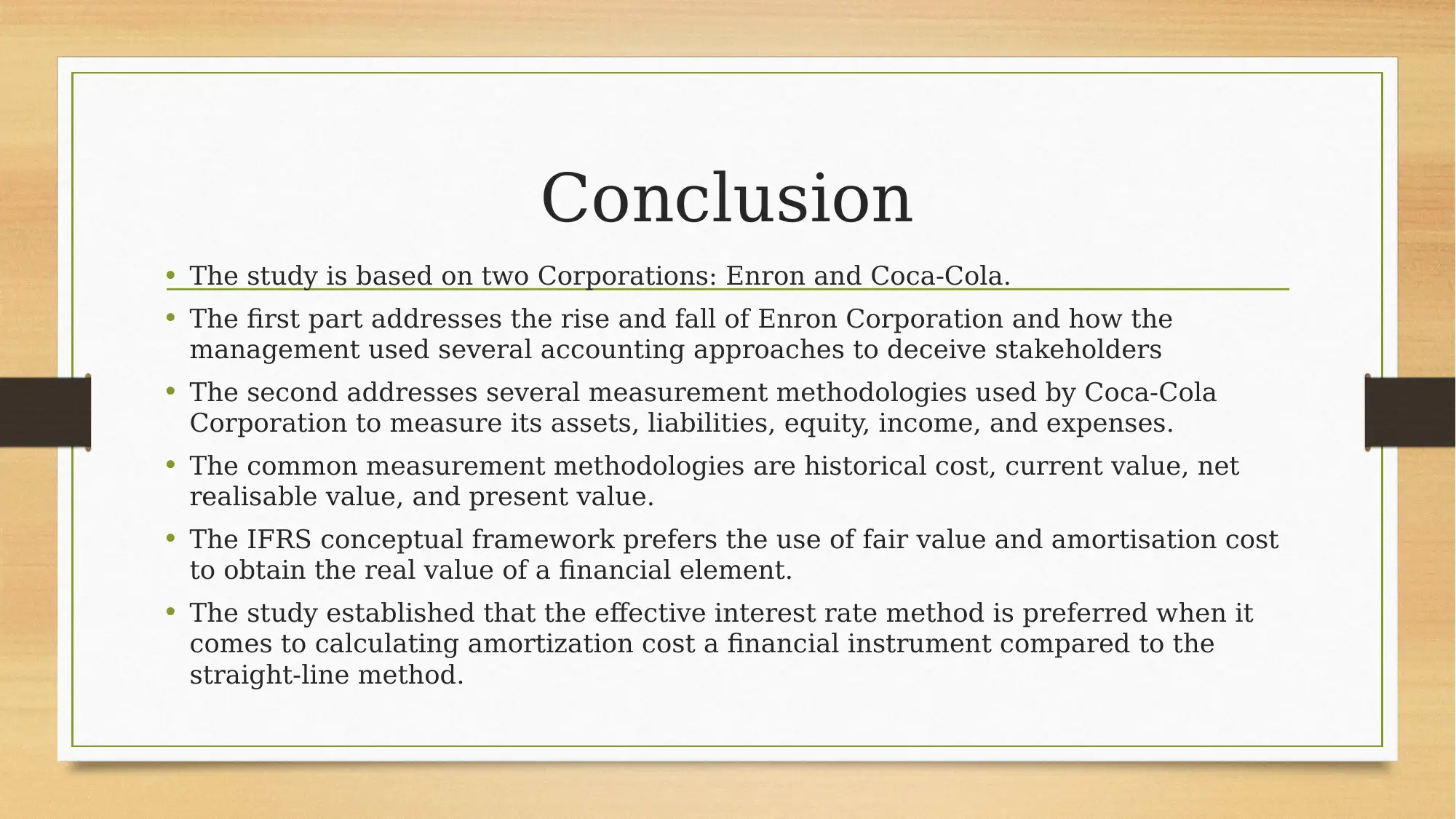
Conclusion
• The study is based on two Corporations: Enron and Coca-Cola.
• The first part addresses the rise and fall of Enron Corporation and how the
management used several accounting approaches to deceive stakeholders
• The second addresses several measurement methodologies used by Coca-Cola
Corporation to measure its assets, liabilities, equity, income, and expenses.
• The common measurement methodologies are historical cost, current value, net
realisable value, and present value.
• The IFRS conceptual framework prefers the use of fair value and amortisation cost
to obtain the real value of a financial element.
• The study established that the effective interest rate method is preferred when it
comes to calculating amortization cost a financial instrument compared to the
straight-line method.
• The study is based on two Corporations: Enron and Coca-Cola.
• The first part addresses the rise and fall of Enron Corporation and how the
management used several accounting approaches to deceive stakeholders
• The second addresses several measurement methodologies used by Coca-Cola
Corporation to measure its assets, liabilities, equity, income, and expenses.
• The common measurement methodologies are historical cost, current value, net
realisable value, and present value.
• The IFRS conceptual framework prefers the use of fair value and amortisation cost
to obtain the real value of a financial element.
• The study established that the effective interest rate method is preferred when it
comes to calculating amortization cost a financial instrument compared to the
straight-line method.
⊘ This is a preview!⊘
Do you want full access?
Subscribe today to unlock all pages.

Trusted by 1+ million students worldwide
1 out of 12
Related Documents
Your All-in-One AI-Powered Toolkit for Academic Success.
+13062052269
info@desklib.com
Available 24*7 on WhatsApp / Email
![[object Object]](/_next/static/media/star-bottom.7253800d.svg)
Unlock your academic potential
Copyright © 2020–2025 A2Z Services. All Rights Reserved. Developed and managed by ZUCOL.





